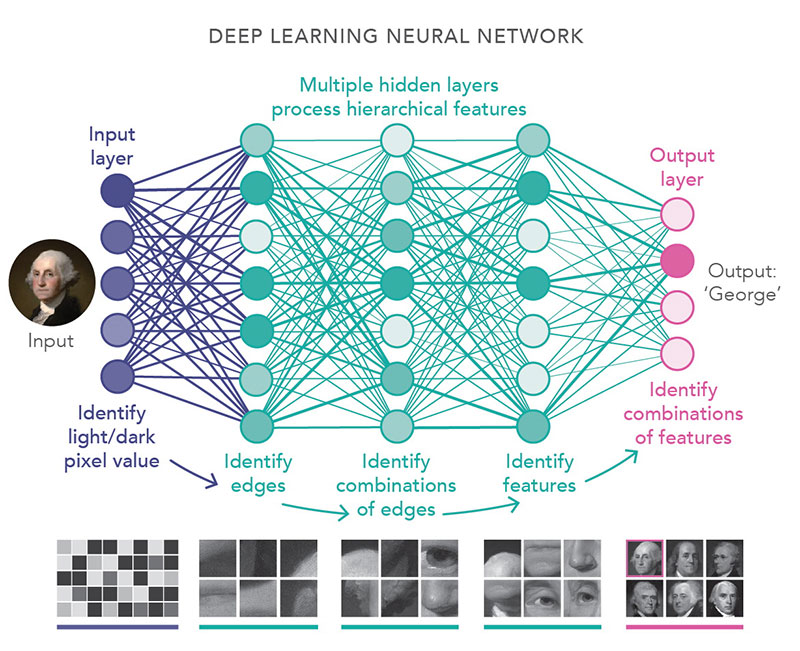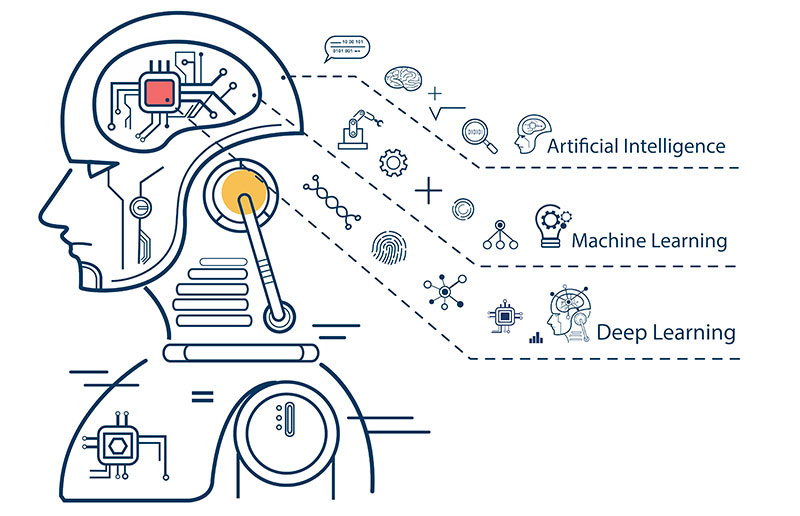Abstract
Our ancestors have passed hundreds of thousands of years of evolution, have had so many troubles, plenty of wars to win, many dangers to skip from, and always the only factor that caused this race to survive was using the intelligence to learn, use and teach all the lessons they passed successfully to the next generations which each add something and passed to the next.
Now, after all the achievements our glamorous history obtained, we intended to simulate our intelligence, but as it is far from nature, we have called it Artificial Intelligence. Mostly artificial and artificial products have less quality than what nature has already served us.
This time, we are going to make a difference, and maybe this time, the tide has turned, and we will make a remarkable revolutionary change. However, some people believe that AI might be the beginning of our end.
Introduction
We can define Artificial Intelligence in a few words as using computer science (software and hardware) to simulate the human brain outcomes against external stimuli like emotions, answering questions, and even doing other tasks like identifying our identities by detecting fingerprints, irises, hand veins, voices, and even our faces.
However, AI has different branches, but primarily the mechanism is based on some initial predefined orders and rules, gathering data over time, verifying them, processing them, storing them, learning them, and use to prepare the proper responses in unknown future situations.

The Theory of AI
AI is a theory based on the concept that programmed machines or computer systems act precisely like a human brain, receive the data, process it, and refer to experiences to prepare the best match answer and dialogue with the human if necessary.
What is AI?
The theory and development of computer science enable us to leave tasks to perform without requiring human intelligence but simulating it in different branches such as visual perception, speech, decision-making, and translation.
AI or Artificial intelligence is a simulation of human intelligence and perception. In it, a computer or a machine enters a dialogue or interaction and must process like a human and prepare the proper answer for its clients. In an AI system, users or clients communicate with a machine like a real person, which processes the language and tries to understand, find, and give appropriate responses.
Different Concepts of AI
There are four main concepts for AI, including Reactive Machines, Limited Memory, Theory of Mind, and Self-aware:
– Reactive Machines work based on the mechanism in which the technology enables the machine to respond to an external stimulus in real time but can’t keep the experience-based memories in the form of information to use in the future.
– Limited Memory is the type that Machines store the received data in the form of knowledge they somehow learn to train themselves to use the achieved knowledge for their future tasks.
– Theory of Mind which seems more complicated is the concept of AI that senses and responds to human emotions combined with performing the tasks of limited memory machines, which we’ve described earlier.
– Self-aware is the final phase in AI technology, in which machines have a sense of self in the combination of the mentioned abilities to receive environmental stimuli and emotions from humans, save, process and use the knowledge in the future.
Ten AI Associated Technology
1. Natural Language Generation
NLP is a segment of AI within computer science focusing on helping computer systems to comprehend how the human brain manages to write and speak and generate text that appears to be written by a human when there was no human actually to write it. This task is highly challenging because it involves a lot of unstructured data.
2. Speech Recognition
Speech Recognition in AI technology is the ability that allows computers or applications to receive human speech data and understand it.
We have been familiar with this feature in the past few years, for example, in Siri from Apple, Alexa from Amazon, Google Assistant, and Microsoft Cortana.
In this branch of AI, machines with artificial intelligence learn to recognize a person’s words or language dialectics and pronunciations and then translate the content into text. It’s important to note that this technology is still in its infancy but is improving accuracy rapidly.
3. Virtual Agents
IVA (Intelligent Virtual Agents), the so-called Virtual Agent, is a branch of AI technology that programmed computers to use predefined rules to do a specific task that best meets their client’s needs.
In IVA, machines collect relevant information and process customer intent to provide personalized answers, including assisting them with basic troubleshooting. However, they sometimes interact with customers in a more human-like way and tonality.
4. Decision Management
Decision management is the combination of Machine Learning ability with pre-defined business rules that organizations use to receive processes and understand to take the best possible action without human interference.
It takes place in big businesses’ Automation approach. Still, it is something more because here machine is making a decision based on pre-defined rules and gathered information to assist companies in responding to their clients more wisely with fewer errors.
5. Biometrics
Biometric applications are a combination of computer programs or other devices to identify individuals’ identities based on their biological characteristics or behaviors (e.g., fingerprints, irises, hand veins, voices, and even using faces).
6. Machine Learning
Machine Learning, or ML, uses mathematical data models to enable computer systems to continue to learn and improve themselves based on experience and predefined mathematical formulas.
ML allows the models to learn and grow more accurately over time.
7. Robotic Process Automation
RPA is a branch of software technology that builds, deploys, and manages software robots that simulate humans’ actions in real life and samples of this technology to do every work as a human does.
8. Peer-to-Peer network
P2P networks refer to a network of connected computing devices with the assistance of software like simple home local area networks or a public network, such as the Internet.
P2P networks and their direct connection allow each device to share files without requiring a remote server’s assistance. This makes the network data exchange faster and more secure than known old-fashioned computer networks.

An example of a deep learning model that identifies an image. From an article on deep learning for the U.S. National Academy of Sciences. Image credit: Lucy Reading-Ikkanda (Nvidia blog).
9. Deep Learning Platforms
Deep learning is an essential element of data science, including statistics and predictive modeling and a subset of Machine Learning and Artificial Intelligence using multi-layered artificial to mimic the human brain neural networks for object detection, speech recognition, language translation, and others through gathering processing and using data.
10. AI-Optimized Hardware
AI Optimized Hardware is an active learning-based AI that asks queries of humans to obtain more data and usually uses the same algorithms explicitly designed or modified branches of machine learning algorithms that achieve greater accuracy with fewer training labels to receive, process, and store considerable amounts of data and provide enhanced computing power to choose the data from which it has already learned.

The Top 5 AI Platforms
- Google AI Service from Google Corp
- Watson from IBM
- NVIDIA from NVIDIA
- CHAT GPT from OpenAI
- Azure from Microsoft
AI Cryptocurrencies (Coins & Tokens)
When Artificial Intelligence technology (AI) meets Blockchain technology and cryptocurrencies in the same arena, we must expect a marvel in the future of finance, technology, and the blockchain industry.
Cryptomarket have had several turbulences, and we always witness dreadful fluctuations in this technology and finance half-blooded phenomenon.
On the other side, AI, however, has a long rocky road ahead, but it is a familiar keyword for many people worldwide.
As mentioned earlier, AI has four main mechanisms, a developer team can per-define some rules, launch them, and the system could have the ability to receive data, save them, learn from and to take action in the future.
Now if the pre-defined rules are the legal regulations of DeFi and this system is at the exposure of the market to interact with real traders, people, and companies.
DeFi has its advantages and weaknesses, and AI has its pros and cons.
But the speed, security, and scalability of Blockchain technology, with the intelligence and continual improvement in the AI machines and software and their tremendous potential in learning and decision making, can make a perfect branch of financial science for our generations and who will come afterward.
We already have lots of AI cryptocurrencies and Tokens in the market. According to the CoinGecko website, the total AI cryptocurrencies market cap at the time of writing this article on February 7th, 2023, exceeds USD2.2B with about USD1.3B 24H trading Volume.
To 5 AI Crypto / Tokens
| Coin / Token | SIGN | $ | Market Cap (Feb 7, 2023) |
|---|---|---|---|
| SingularityNET | AGIX | 0.5434 | $651,256,968 |
| Fetch.ai | FET | 0.5466 | $573,203,099 |
| Artificial Liquid Intelligence | ALI | 0.0835 | $298,714,576 |
| Ocean Protocol | OCEAN | 0.5325 | $231,363,208 |
| Numeraire | NMR | 23.98 | $147,519,978 |
Conclusion
There are four different mechanisms for AI: Reactive Machines, Limited Memory, Theory of Mind, and, Self-aware.
We can use AI in every aspect of our modern life, from a hospital operation room, a stock exchange, aviation, finance, psychology, and almost everywhere, even to make a companion for ourselves.
However, from the scientific POV, we have investigated the types of AI and the role Artificial Intelligence plays if the blockchain industry and DeFi scope. AI can act like a programmed bot, like what we see daily on social media platforms, Google something, or even use our smart device assistants.
In Defi and the blockchain industry, we have acceptable speed, considerable security, and scalability. Still, there are some unknown factors in the market that we cannot control with the mentioned instruments.
Here is where AI comes to help!
If we integrate DeFi and AI, we can circumvent scammers, potential risks, and fatal factors we know nothing about yet. If we want to be fair must confess that we are on one of the most remarkable turning points in human history, but if it will be victorious or will be the end of us is what the future will make clear.


